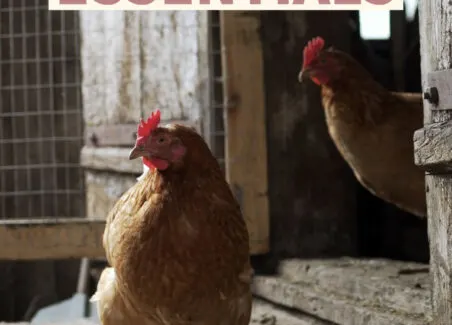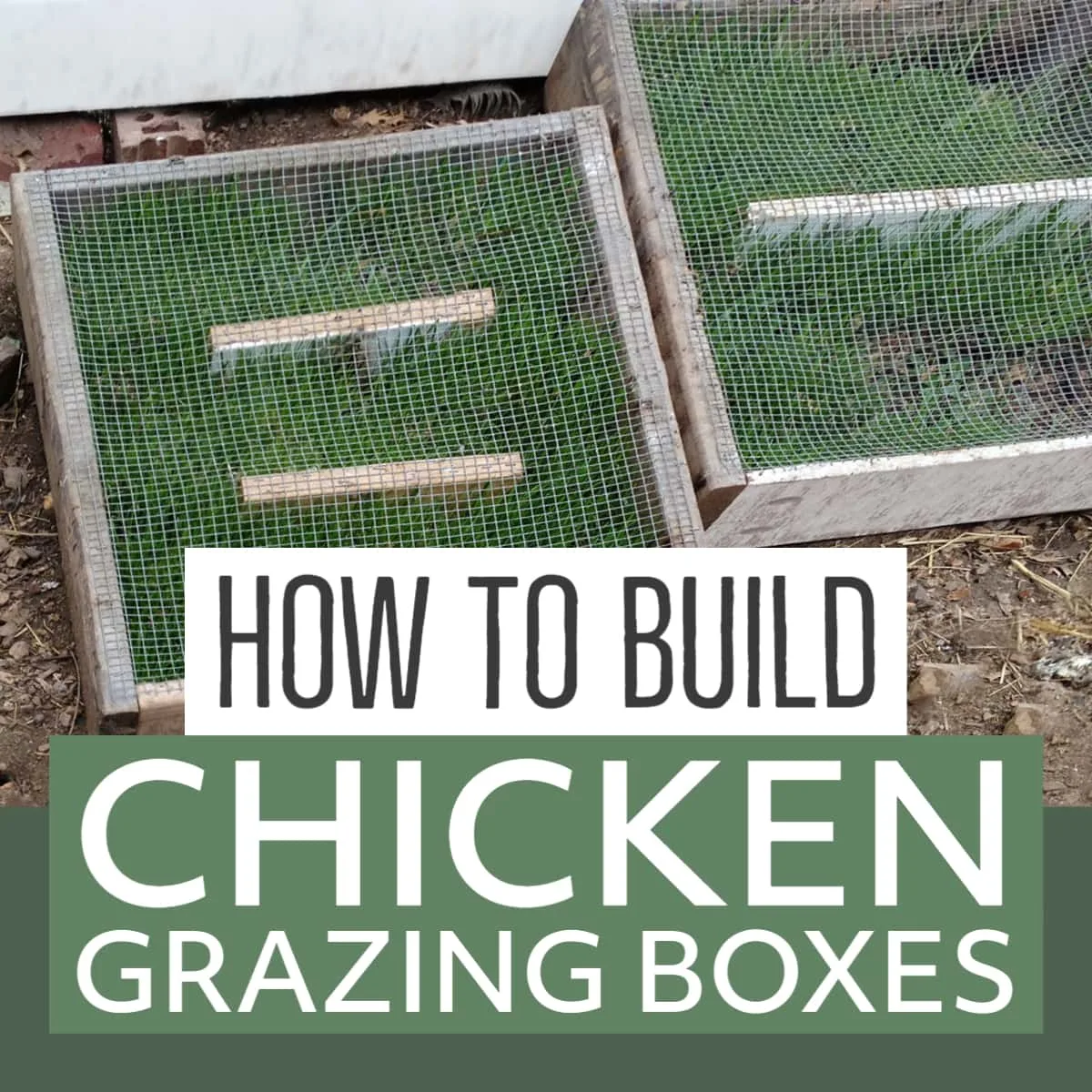Are you ready to embark on the exciting journey of building your own home chicken coop but have no idea what belongs inside a chicken coop? You certainly aren’t alone, and don’t worry, the benefits of having your own flock of chickens far outweigh the initial frustration of learning about care, coop construction, and what should be inside.
In this article, we’ll cover:
- A quick summary list of the essentials that belong inside a chicken coop, and a more in depth exploration of what these items are and why you need them – plus a free printable checklist version for easy planning.
- An inside look at the interior layout of my chicken coop- originally constructed around 1920!
From perches to nesting boxes and everything in between, in this article, we’ll discuss everything that belongs inside a chicken coop and why.
This article is about things that should be inside of a chicken coop for happy, healthy chickens, but for a glimpse inside a chicken coop- be sure to check out my 100-year-old coop tour interior view.
Quick List of Things that Belong Inside Chicken Coops:
- shavings or bedding
- perch
- nesting boxes
- nesting box liners
- bird bath water deicer (winter)
- lights
- light timer
- chicken waterer + water
- feed pan + chicken feed
- dust bath box
- grazing boxes (in run)
- chicken-resistant landscaping (in run)
Download this Simple checklist of Things you need inside your chicken coop
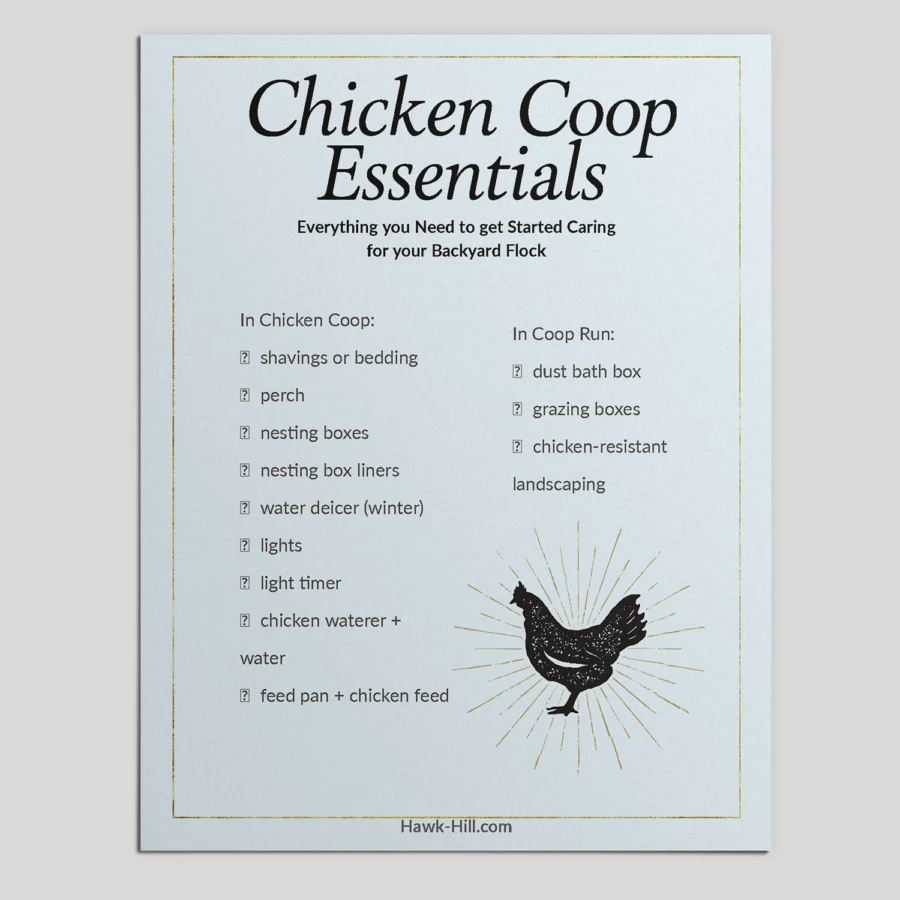
A Closer Look: Things That Should be Inside a Chicken Coop
A Secure Floor, Walls, and Roof
Let’s start with the basics. A floor is an essential to any coop, as it keeps the coop secure and helps prevent snakes and other backyard predators from making their way in. The floor inside your chicken coop will likely be made of wood, dirt, or plywood.
Some coops, like my 1920’s coop, have rock or cement floors. The roof should be made from sheet metal, PVC, or other modern roofing materials that are designed with water resistance in mind. You’ll also want to make sure that you include a door that can be bolted or sealed shut and cannot be opened on the outside by any pesky intruders who lack an opposable thumb. Secure latches and padlocks are popular options to ensure safety.
The following section may contain affiliate links. As an Amazon Associate, we earn from qualifying purchases.
Perches / Roosts
In the wild, chickens sleep high up on branches to protect themselves from the various animals below that are on the hunt. While your chicken coop inside should be a cozy and safe place that protects them from said predators, chickens are more comfortable sleeping up high, so make sure that they are able to retreat to roosts when they’d like.
Setting these up won’t be too difficult; they can be constructed with simple wood (2×4’s fixed with the wide side up make the best perches for coops in winter climates- read why here). Install the roosts inside your chicken coop at the highest point in the coop.
Ideally, these roosts will be at least two feet off the ground and keep chickens far above the dirty little below. In terms of size, ideally your entire flock will should able to rest on the roost comfortably.
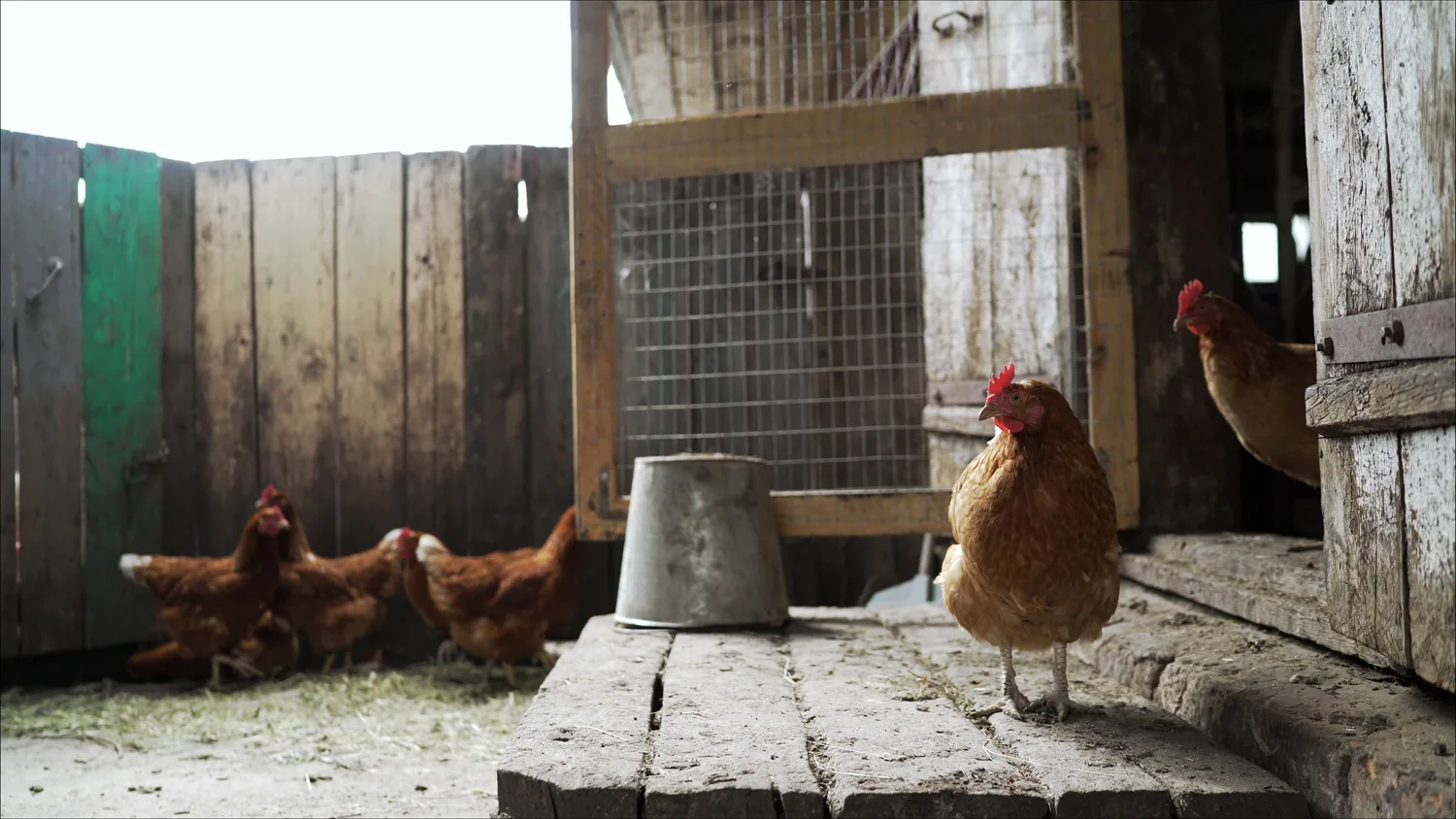
Bedding Material like Wood Shavings
Depending on the size of your coop, you can buy packaged bags of coop bedding material- like wood shavings- in plastic bags at farm stores. However, to save (a lot) on bedding costs, cut down on plastic waste, and spend less time cleaning your coop, consider using the deep litter bedding method.
Deep litter beddings involves getting a big load of wood shavings delivered and spreading a thick layer on the floor of your coop. As bedding is soiled, the bedding inside your chicken coop can be turned or merely sprinkled with fresh bedding until one big cleanout once or twice a year.
Nesting Boxes
Nesting boxes definitely belong inside a chicken coop. They are the safe haven where your chicken will lay eggs (and where you’ll retrieve your breakfast from).
To encourage your chickens to lay comfortably and safely, the boxes should be dark and elevated off the ground (but be sure the nesting boxes are mounted lower than the roost- or you’ll have hens sleeping and pooping in egg laying nests which, according to Colorado State University Extension Office, can be a source of foodborne illness in humans).
Making your own nesting boxes is quite inexpensive. Many owners even repurpose shoe boxes, gallon buckets, milk crates, and flower baskets. The possibilities are endless. You’ll also want to have a few golf balls or plastic eggs on hand to appear like recently laid eggs – chickens like to lay their eggs in spaces they believe other chickens have used before.
Keep in mind, nesting boxes should be cleaned regularly to ensure that your chickens won’t be subject to disease and your eggs will stay clean. You’ll also want to be sure not to overcrowd the boxes; the ideal ratio is 4 chickens per box (see my tips for handling it when all the hens want to lay in the same box). Reach through nesting boxes are preferrable for faster egg collection, but not essential.
Nesting Box Lining
Most novice chicken owners line nesting boxes with hay or stray- which hens unceremoniously scratch out of the box before laying! Instead, I recommend using my guide to making soft, washable nesting box liners using artificial turf (here’s my full guide to sourcing and installing nesting box liners)
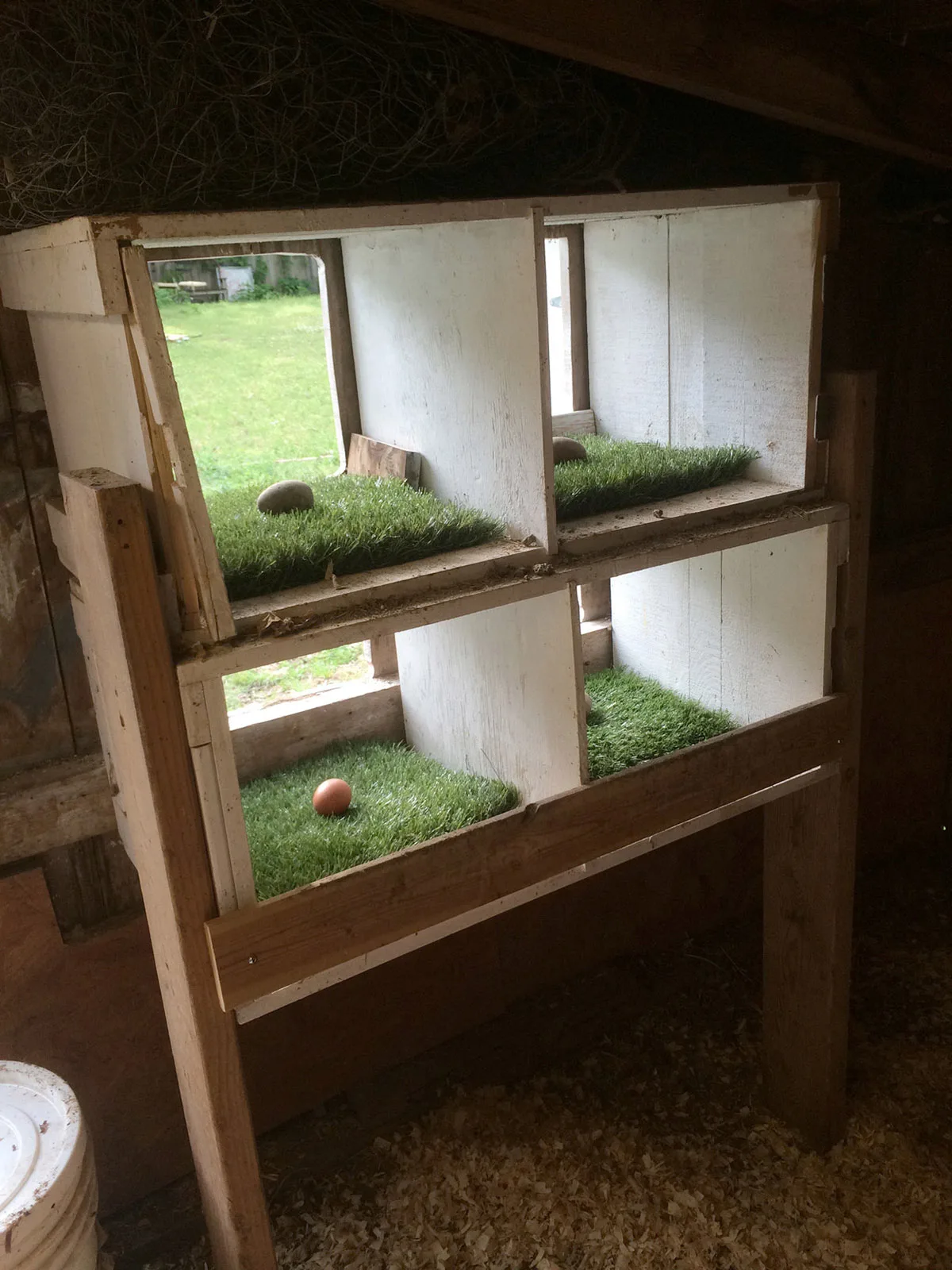
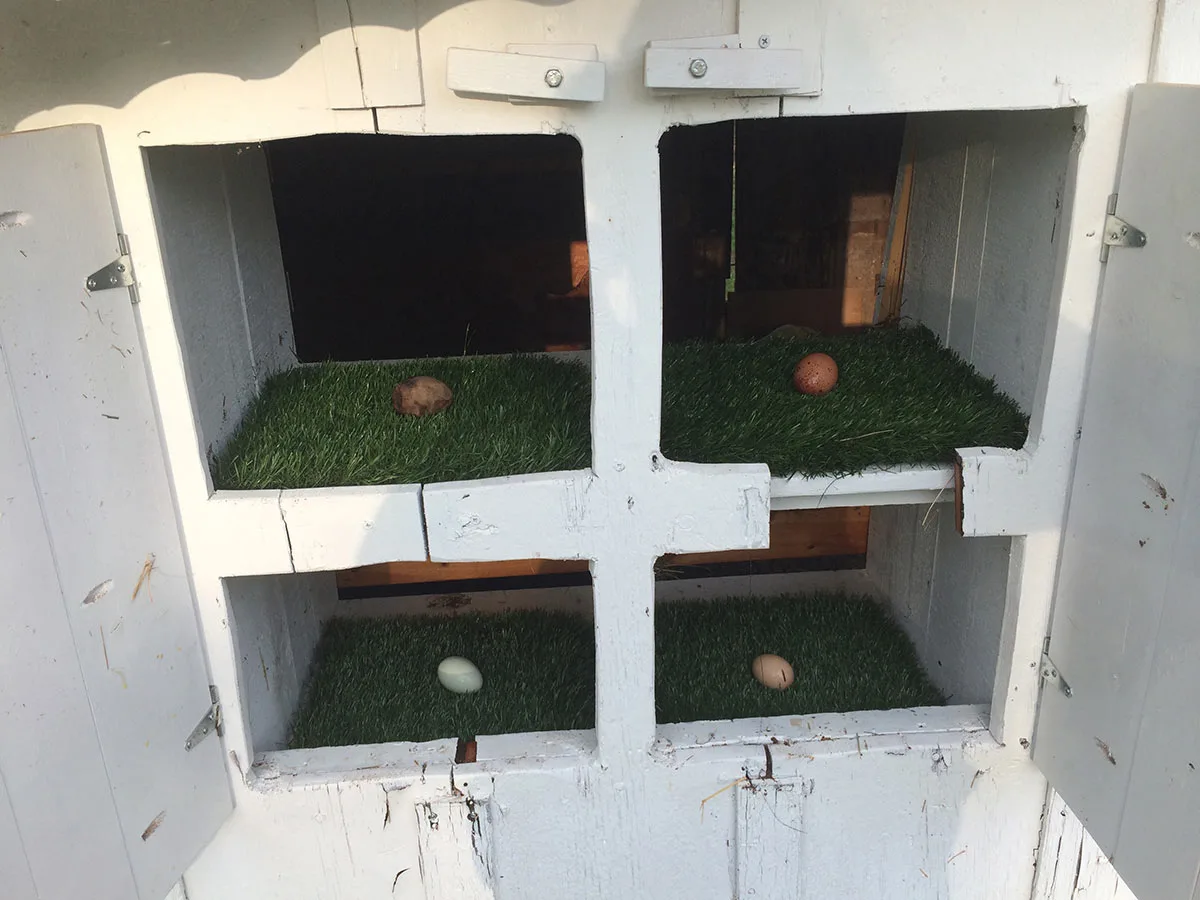
Insulation
Cracks and openings not only subject your animals to the turns of the weather, but can also allow predators such as snakes and mice to enter the coop.
Carefully balance insulation with ventilation inside your chicken coop – screens can make sure that air is able to circulate properly and prevent your chickens from overheating or being trapped inside with poor quality air. Many coop owners opt for screens to ensure proper ventilation throughout the seasons – it can be easily boarded up during the cold winter months.
Heat Protection
If you live in an area that gets warm, you’ll want to make sure your roof is prepared to protect your animals from extreme heat. Consider a roof sheathing that can act as a barrier against extreme heat. This is another instance in which ventilation from screens is a great benefit.
Lighting
Chickens’ reproductive cycles are facilitated by natural light, so egg production will likely come to a halt if the coop fails to have proper lighting inside. Windows are recommended in chicken coops, although if you live in an area that is particularly dark, you can turn to artificial lighting to extend the daylight hours and boost egg production.
Ideally, plan ahead for long, dark winter months by purchasing and installing artificial lamps (opt for full spectrum LED lights) and a mechanical timer that will turn lights on for a few hours before dawn, and a few hours after dusk. I recommend against electronic timers, as the dusty environment tends to render them useless after a few months- while older mechanical styles keep working.
Litter Trays
If you use litter trays placed in the proper place, you won’t need to clean out your coops bedding from the inside as often.
A litter tray is an easy-to-clean material placed directly under the spot where chicken’s roost for the night. Most manure will drop directly onto the litter tray where it can be easily cleared.
Clearing your coop from chicken poop is less daunting of a task than it may sound. We recommend lining litter trays with newspaper and switching it out daily. This will take mere minutes – a small price to pay for your fresh eggs!
A Steady Feed and Water Supply
You should budget about ¼ of a cup of feed per day per chicken. For budgeting purposes, feed is about $20 for a fifty pound bag as of 2022. Chicken feeders range from small dishes that hold a day’s worth to big feeders. To save time on chores, see my DIY guide to building a chicken feeder that holds an entire 50lb bag.
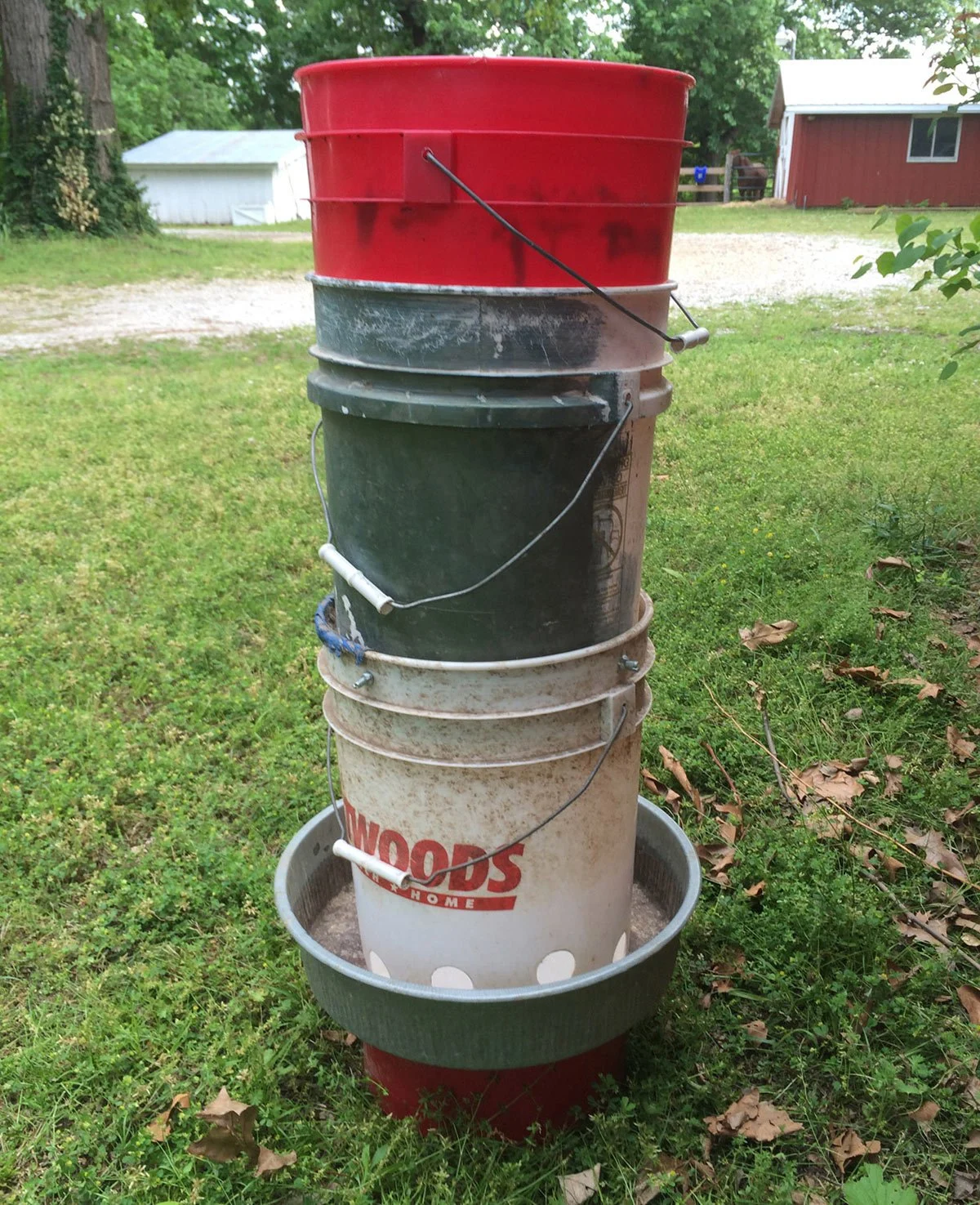
Water is another essential that belongs inside a chicken coop, since dehydrated chickens are prone to disease and will produce far fewer eggs than hydrated and strong chickens.
It’s best that the chickens have 24/7 access to feed and water to ensure that they stay as healthy as possible and continue to produce eggs. You should leave water in your coop overnight unless you expect it will freeze, in which case you should plan to provide fresh water again first thing the next morning.
Water Deicer
I cannot recommend enough that you prepare for winter chicken keeping before you find yourself in the thick of it. An investment in a bird bath heater can give you piece of mind that your chickens have water even on the coldest nights- while sparing you from hauling buckets of fresh water first thing in the morning on a frigid day. A bird bath deicer like the one I use is a small device that provides just enough heat to keep a small metal pan or bucket from freezing solid.
Dust Baths
Chickens love to roll around in the dirt, but in fact, this is an important behavior that keeps them clean! Chickens have very active oil glands, and the act of rolling in the dirt allows them to clean themselves. Adding helpful minerals or diatomatious earth to your dust bath, as including in prepackaged chicken dust bath mixtures, can be a helpful way to keep your chickens health and laying.
While your chickens will dust bathe while free ranging, if you want to provide a fortified dust bath, it’s best to place a box in an out of the way corner of the inside of your coop and fill with dust bath mixture.
Runs
Runs with fencing are essential in making sure your chickens are able to get fresh air, explore the world, and stay healthy and happy. Experts recommend that you allow about 5 square feet per chicken – you can enclose the area using t-posts or wooden fence posts. Overcrowding will cause conflict among your flock, causing them to fight more and potentially injure each other.
Chicken Grazing Boxes
Chicken grazing boxes are my own invention! Since shared far and wide on the internet, thse elevated frames make it possible to supply fresh greens to birds confined to inside of a chicken coop and an external chicken run. The elevated grid lets grass grow, allows chickens to nibble, but protects the tender root structures needed for plants to thrive. Read the step by step guide and download the plans to make a chicken grazing box here.
There are so many benefits you’ll experience by starting our right and considering what should be inside a chicken coop. It’s our hope that our clear must-haves for coop interiors have made the construction process feel far less daunting and have set you up to embark on your journey to housing a happy and healthy flock. To learn more about general tips for chickens, read my guide to creative chickenkeeping.
Look Inside my Chicken Coop: Interior Photos
I am lucky to have a very unique chicken coop – on the grounds of Hawk Hill stands a tiny 100 year old building – a chicken coop built by the original owners.
You can see photos of the outside of it in my coop tour. As was typical for the era, my chicken coop is much bigger than a typical backyard coop. Though I have to stoop just slightly to enter, it is possible to enter the interior of my chicken coop to take pictures from the inside. Chicken tractors, however, are usually better than coops for raising chickens to butcher.
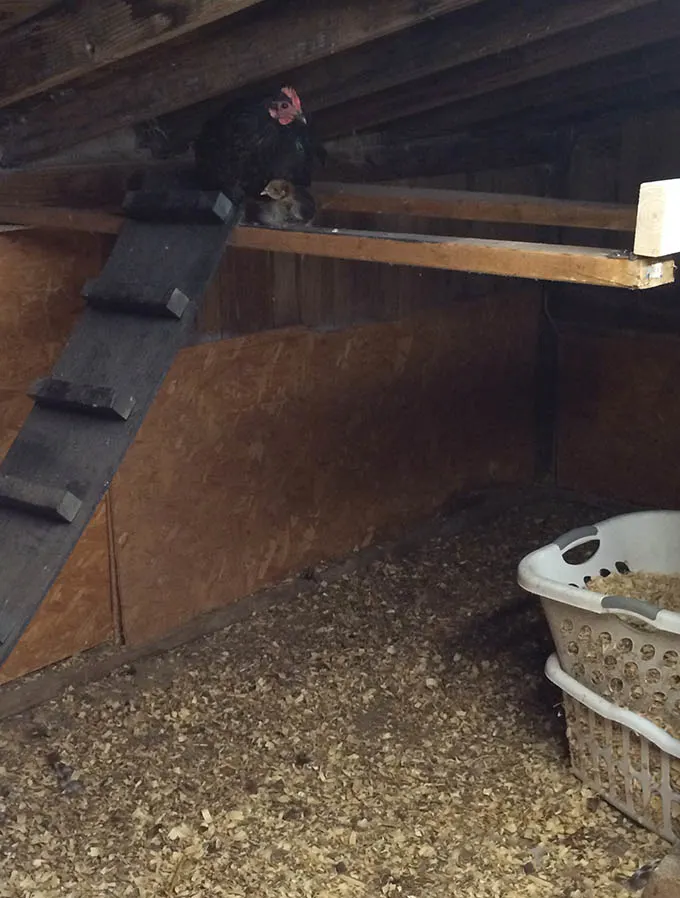
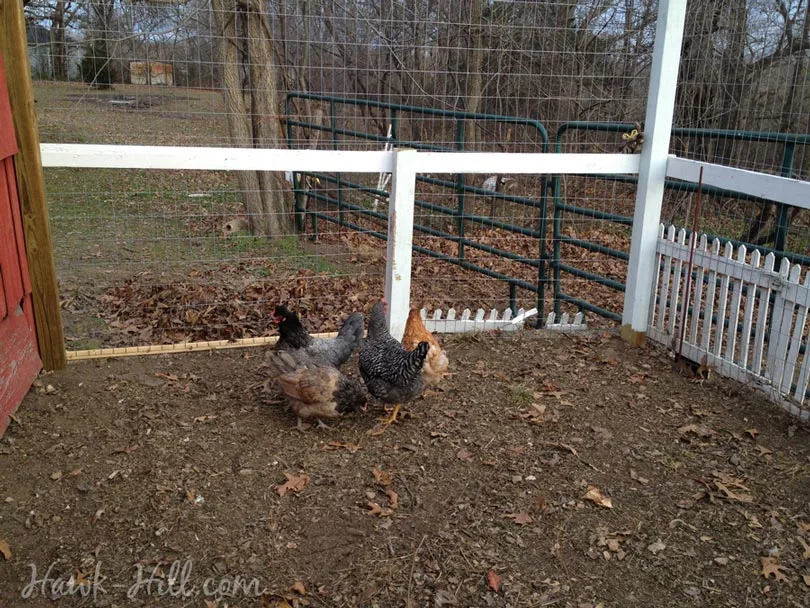
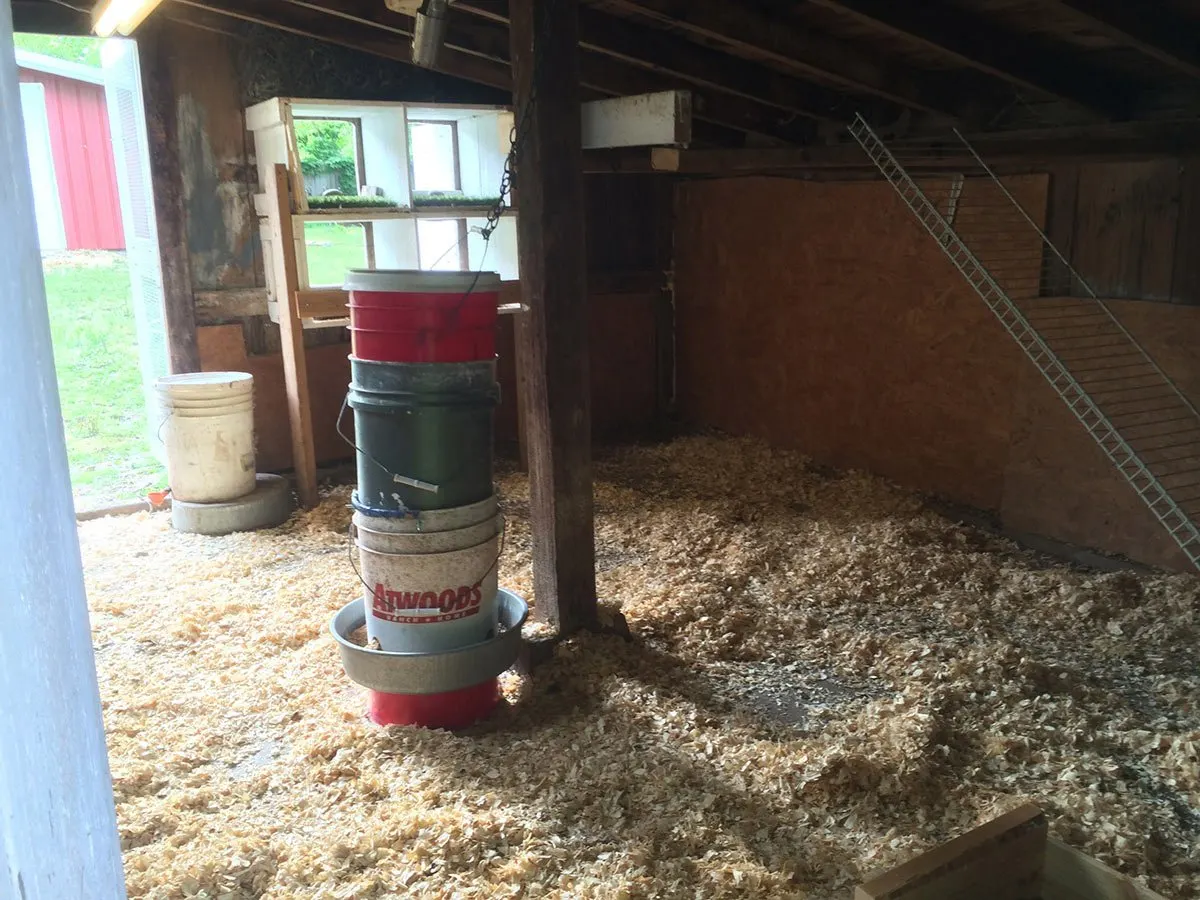
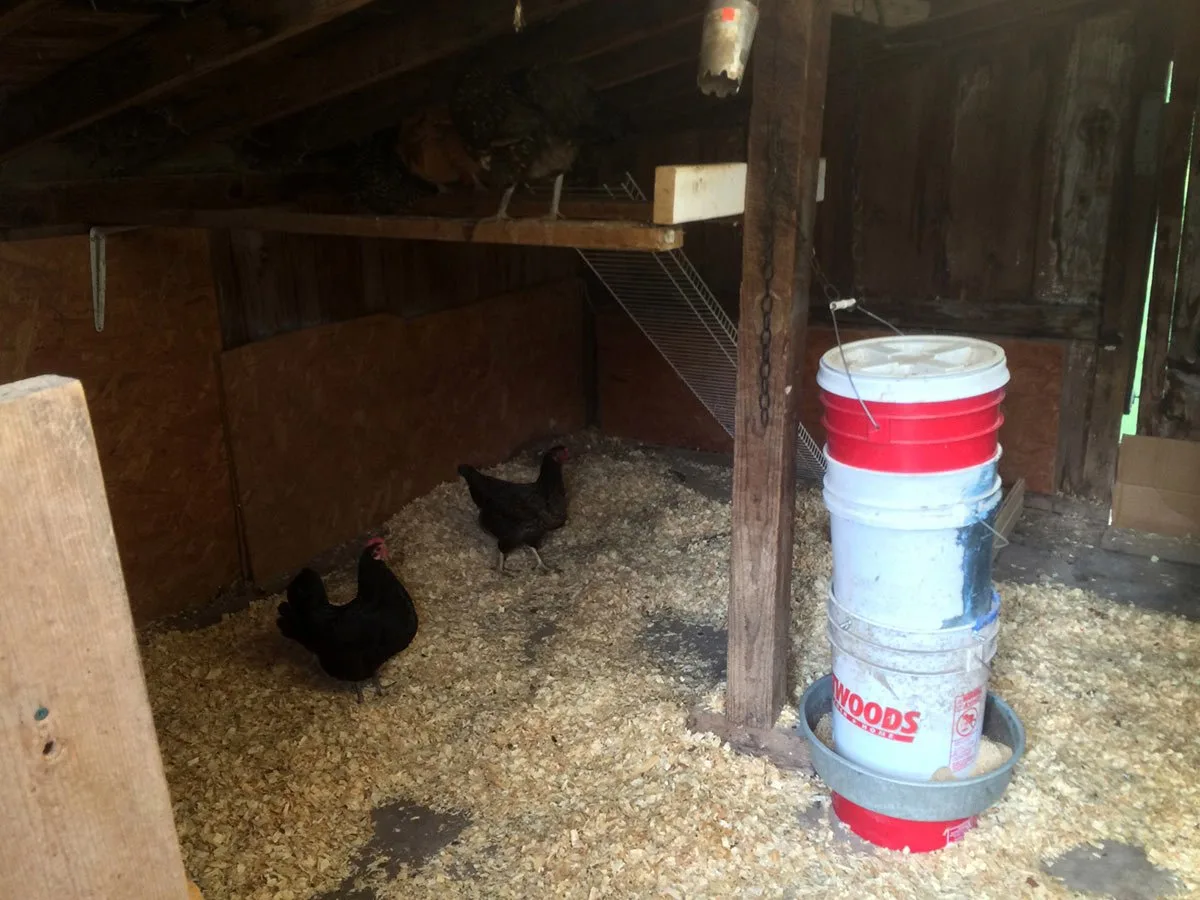
Chicken coop interior walls
A lot of chicken owners and coop builders don’t give a lot of thought to walls, but both interior and exterior walls of a chicken coop are important for security and insulation.
As I mentioned in my post on getting your chickens to lay eggs all winter, insulating your chicken coop is a really easy way to raise the temperature and help your chickens keep laying through the winter. The nice thing about a chicken coop interior is that few people ever see it, so it’s easy to pick up inexpensive insulation or mismatched paneling to make your coop more comfortable for your chickens – even if it’s not so pretty.
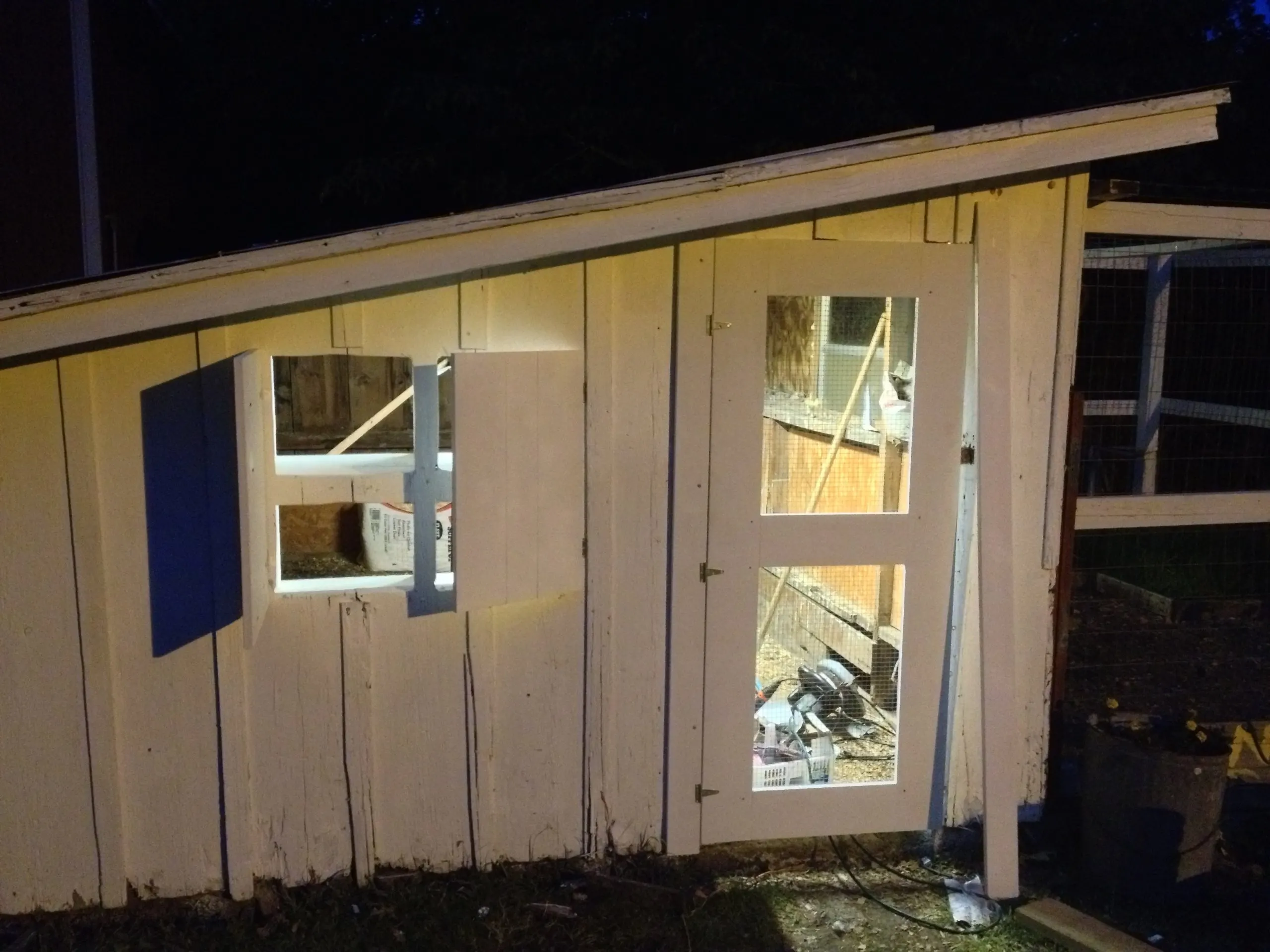
Best chicken coop interior layout
If you look closely at the images of my chicken coop, you’ll notice a few things: 1 it’s built into a hill in the style of a “bank barn,” which means the first floor “walks out” to a ledge on 2.5 sides. And 2, the roof is slanted. I think both of these design elements make my coop one of the best interior layouts for a chicken coop.
Sloped roof on a chicken coop maximizes space while minimizing building cost
The sloped roof takes advantage of being able to use minimal building materials – while I can walk into the inside of the coop via one door and out the other on the opposing side of the tallest portion of the building, it’s easy to use a rake to reach into the shortest part of the building.
Bank barn style construction makes cleaning a breeze!
This is where the genius of the builder of my chicken coop comes in- the chicken coop has a cement foundation which is built into a hill in the style of a bank barn. While the foundation is level, the ground around it goes from level with the foundation to about 2 1/2 feet raised up from the ground around it on the other end.
This design not only helps my chicken run drain effectively so I don’t have to deal with standing mud, it also means that cleaning out my chicken coop is as easy as parking a wheelbarrow under the cleanout door and using a push broom to push soiled butting into the wheelbarrow below.
Now that I’ve had a chicken coop interior with a cleanout door and way to use gravity to help me clean the coop, I wouldn’t have it any other way! What’s your favorite feature in your chicken coop?
Thanks for Reading!!!
I hope you can tell that I love DIY, researching the best affordable solutions for every-day problems opportunities and documenting / sharing solutions!🙌 Hawk-Hill.com is reader-supported.
☕ Hawk-Hill.com is reader-supported. If this article saved you time or money, please consider donating $1 to help me cover the cost of hosting this website OR If you appreciate this information and want to throw a “Thanks!” my way by buying me a coffee – I would Of Course appreciate it! :]
Reader Questions and Recommendations
Readers, do you have any favorite topics / posts? What would you like to read more about in the future? As I hope you can tell from this and other articles on my site, I really enjoy DIY / a good challenge, and I’m not afraid to roll up my sleeves to figure out a great, and hopefully simple 😁 solution. So please feel free to let me know in the comments below (or reach out via social media)!
Ok Really – I’ll try to wrap this up now😂
Finally, if you’d like to continue to learn about interesting DIY options as well as how YOU can tackle creative new projects consider checking out the latest and most popular articles listed on the Hawk-Hill Home Page. I’m always trying to enjoy and write about the creative side of life so please don’t be a stranger – check back often!😍
If you enjoyed this post you may also enjoy reading / perusing / devouring😊 one or all of these articles as well!

